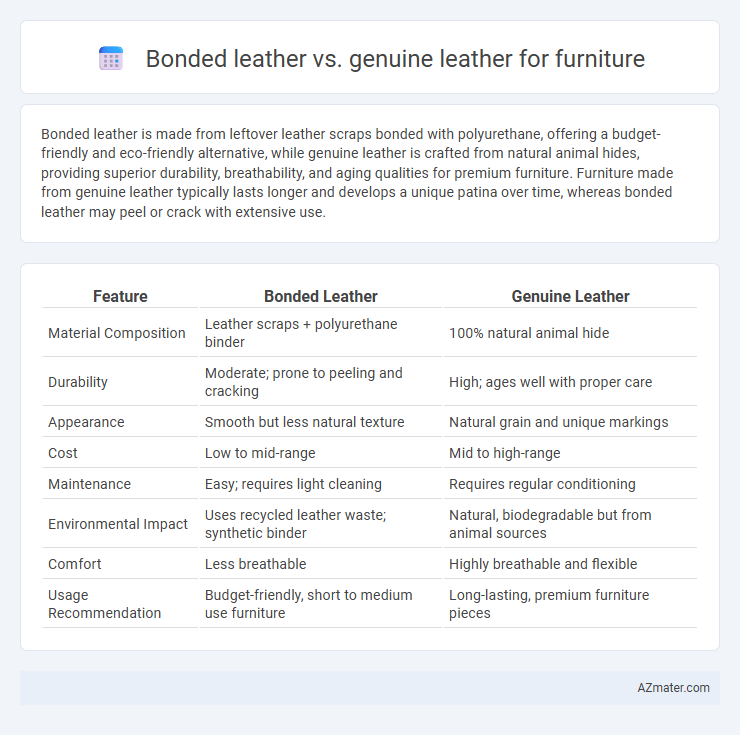Bonded leather is made from leftover leather scraps bonded with polyurethane, offering a budget-friendly and eco-friendly alternative, while genuine leather is crafted from natural animal hides, providing superior durability, breathability, and aging qualities for premium furniture. Furniture made from genuine leather typically lasts longer and develops a unique patina over time, whereas bonded leather may peel or crack with extensive use.
Table of Comparison
| Feature | Bonded Leather | Genuine Leather |
|---|---|---|
| Material Composition | Leather scraps + polyurethane binder | 100% natural animal hide |
| Durability | Moderate; prone to peeling and cracking | High; ages well with proper care |
| Appearance | Smooth but less natural texture | Natural grain and unique markings |
| Cost | Low to mid-range | Mid to high-range |
| Maintenance | Easy; requires light cleaning | Requires regular conditioning |
| Environmental Impact | Uses recycled leather waste; synthetic binder | Natural, biodegradable but from animal sources |
| Comfort | Less breathable | Highly breathable and flexible |
| Usage Recommendation | Budget-friendly, short to medium use furniture | Long-lasting, premium furniture pieces |
Introduction to Leather Types in Furniture
Bonded leather consists of leather scraps and fibers bonded together with polyurethane or latex on a fabric backing, offering an affordable and eco-friendly alternative for furniture upholstery. Genuine leather, derived from the hides of animals through tanning and finishing processes, provides durability, natural texture, and a premium appearance. Understanding the differences in composition, longevity, and maintenance is crucial when selecting leather types for furniture applications.
What is Bonded Leather?
Bonded leather is a material made by combining shredded leather fibers with polyurethane or latex on a fabric backing, offering a cost-effective alternative to genuine leather. It contains a lower percentage of actual leather, typically around 10-20%, resulting in a less durable surface that can wear or peel over time. Bonded leather's texture mimics genuine leather but often lacks the longevity and natural aging properties prized in high-quality furniture upholstery.
What is Genuine Leather?
Genuine leather is natural leather made from the hide of animals, primarily cows, processed through tanning to enhance durability and appearance. It retains the unique textures and pores of the animal skin, offering breathability and aging characteristics that improve over time. In furniture, genuine leather provides long-lasting comfort and strength, valued for its natural look and resilience compared to synthetic alternatives.
Durability Comparison: Bonded vs Genuine Leather
Genuine leather offers superior durability compared to bonded leather due to its natural fiber structure and resistance to wear, making it ideal for high-traffic furniture. Bonded leather, made from shredded leather remnants bonded with polyurethane, tends to deteriorate faster, showing cracks and peeling within a few years under frequent use. The longevity of genuine leather furniture often exceeds a decade, whereas bonded leather typically lasts only 2 to 3 years before noticeable damage occurs.
Appearance and Texture Differences
Bonded leather features a synthetic base coated with real leather fibers, resulting in a smoother, more uniform surface with consistent color and texture but less natural grain variation compared to genuine leather. Genuine leather showcases distinctive, natural markings such as pores, scars, and wrinkles, offering a rich texture that develops character and patina over time. While bonded leather tends to feel more artificial and less breathable, genuine leather provides a supple, durable finish with varied textures that enhance the furniture's aesthetic appeal.
Maintenance and Cleaning Requirements
Bonded leather requires gentle cleaning with a damp cloth and mild soap to avoid peeling, while genuine leather benefits from regular conditioning to maintain its suppleness and prevent cracking. Genuine leather is more durable and resistant to stains, making it easier to clean spills promptly, unlike bonded leather which can degrade faster under frequent moisture exposure. Both materials should be kept away from direct sunlight to prevent fading, but genuine leather's natural fibers allow for more effective long-term maintenance.
Cost Analysis: Bonded vs Genuine Leather
Bonded leather furniture typically costs 30-50% less than genuine leather due to its composite materials and lower manufacturing expenses. Genuine leather offers superior durability, often lasting 10-20 years, which may justify the higher upfront price through long-term value. Cost analysis should factor in maintenance, as bonded leather may require earlier replacement, increasing total expenditure over time compared to the investment in premium genuine leather furniture.
Environmental Impact and Sustainability
Bonded leather, composed of shredded leather fibers mixed with polyurethane or latex, typically has a higher environmental footprint due to synthetic adhesive use and limited biodegradability. Genuine leather, derived from animal hides, involves resource-intensive livestock farming and chemical tanning processes that contribute to water pollution and greenhouse gas emissions. Sustainable alternatives include vegetable-tanned genuine leather and recycled leather blends, which reduce toxic waste and promote eco-friendly furniture production.
Pros and Cons of Bonded Leather for Furniture
Bonded leather for furniture offers a cost-effective alternative to genuine leather, providing a similar aesthetic with a smooth, consistent surface and easier maintenance. It is more environmentally friendly as it utilizes leftover leather fibers combined with polyurethane, but it lacks the durability and breathability of genuine leather, often showing wear and cracking faster. While bonded leather resists stains better and requires less conditioning, it generally does not develop the rich patina characteristic of high-quality genuine leather over time.
Pros and Cons of Genuine Leather for Furniture
Genuine leather furniture offers superior durability, natural breathability, and ages gracefully with a unique patina, making it a long-lasting and luxurious choice. However, it requires regular maintenance to prevent drying and cracking, can be more expensive than synthetic alternatives, and may show imperfections due to its natural origins. Despite higher upfront costs, genuine leather's strength and comfort often justify the investment for premium furniture pieces.

Infographic: Bonded leather vs Genuine leather for Furniture
 azmater.com
azmater.com